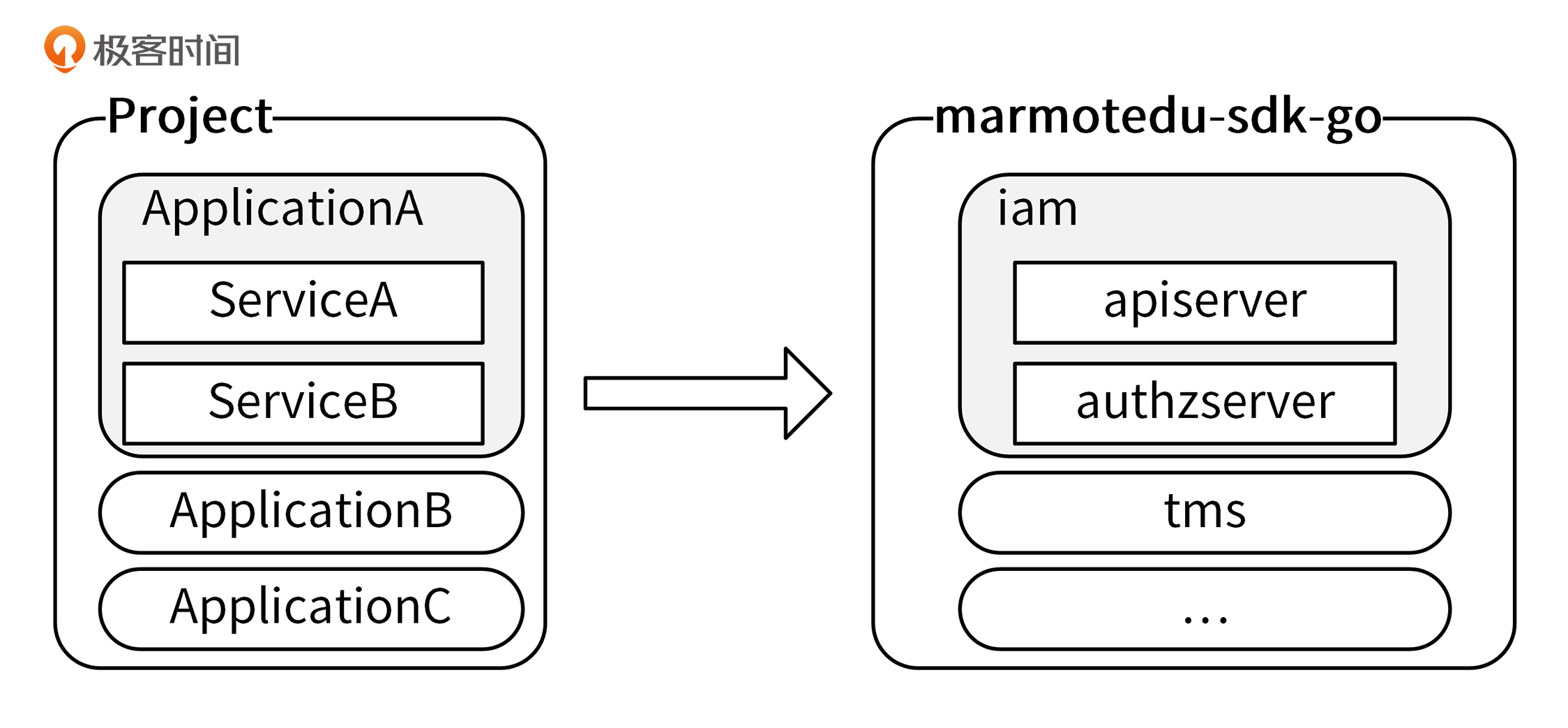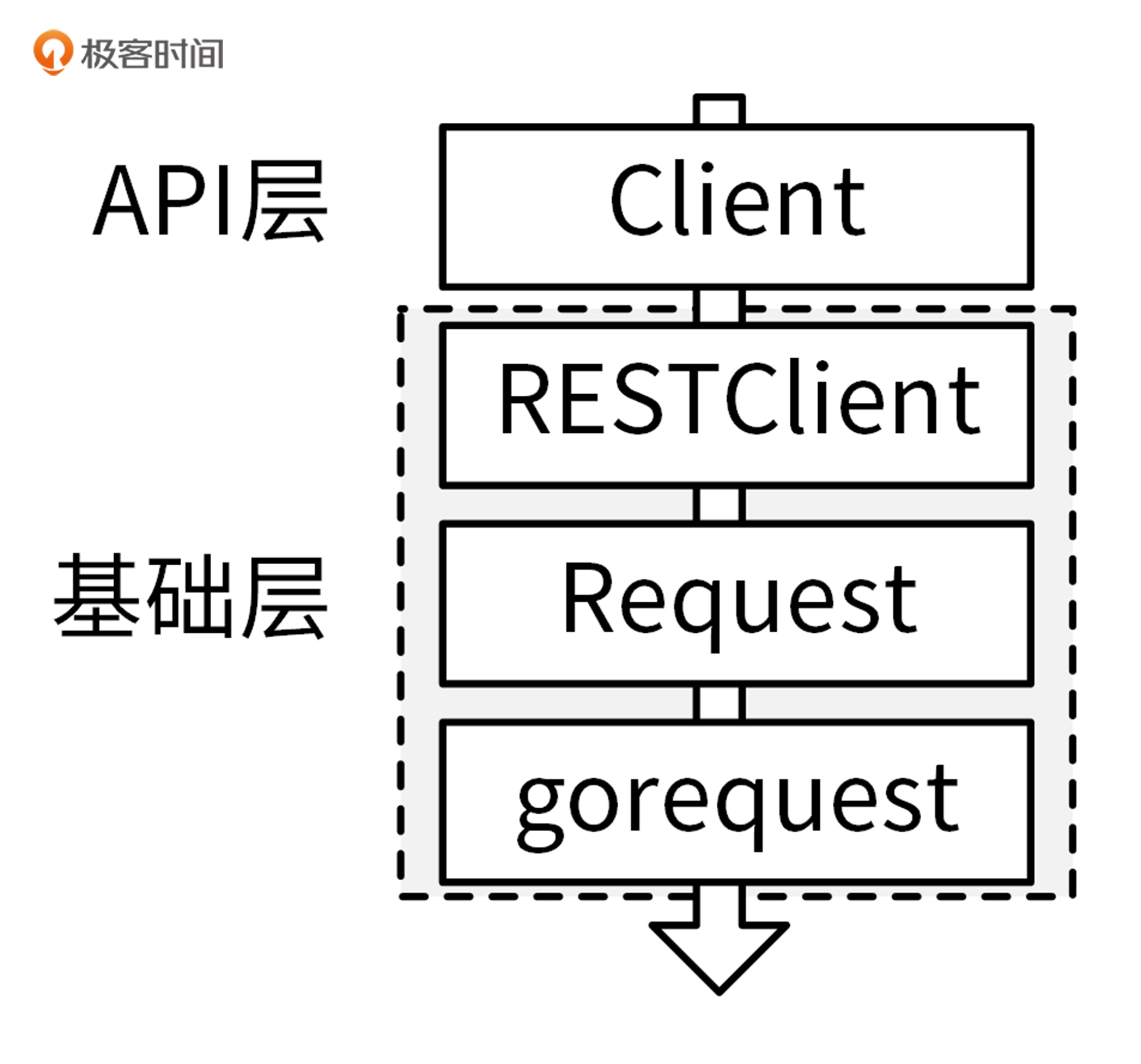34 SDK 设计(下):IAM项目Go SDK设计和实现 你好,我是孔令飞。
上一讲,我介绍了公有云厂商普遍采用的SDK设计方式。其实,还有一些比较优秀的SDK设计方式,比如 Kubernetes的 client-go SDK设计方式。IAM项目参考client-go,也实现了client-go风格的SDK:marmotedu-sdk-go。
和 33讲 介绍的SDK设计方式相比,client-go风格的SDK具有以下优点:
- 大量使用了Go interface特性,将接口的定义和实现解耦,可以支持多种实现方式。
- 接口调用层级跟资源的层级相匹配,调用方式更加友好。
- 多版本共存。
所以,我更推荐你使用marmotedu-sdk-go。接下来,我们就来看下marmotedu-sdk-go是如何设计和实现的。
marmotedu-sdk-go设计
和medu-sdk-go相比,marmotedu-sdk-go的设计和实现要复杂一些,但功能更强大,使用体验也更好。
这里,我们先来看一个使用SDK调用iam-authz-server
/v1/authz 接口的示例,代码保存在 marmotedu-sdk-go/examples/authz_clientset/main.go文件中: package main import ( “context” “flag” “fmt” “path/filepath” “github.com/ory/ladon” metav1 “github.com/marmotedu/component-base/pkg/meta/v1” “github.com/marmotedu/component-base/pkg/util/homedir” “github.com/marmotedu/marmotedu-sdk-go/marmotedu” “github.com/marmotedu/marmotedu-sdk-go/tools/clientcmd” ) func main() { var iamconfig /string if home := homedir.HomeDir(); home != “” { iamconfig = flag.String( “iamconfig”, filepath.Join(home, “.iam”, “config”), “(optional) absolute path to the iamconfig file”, ) } else { iamconfig = flag.String(“iamconfig”, “”, “absolute path to the iamconfig file”) } flag.Parse() // use the current context in iamconfig config, err := clientcmd.BuildConfigFromFlags(“”, /iamconfig) if err != nil { panic(err.Error()) } // create the clientset clientset, err := marmotedu.NewForConfig(config) if err != nil { panic(err.Error()) } request := &ladon.Request{ Resource: “resources:articles:ladon-introduction”, Action: ”delete”, Subject: “users:peter”, Context: ladon.Context{ “remoteIP”: “192.168.0.5”, }, } // Authorize the request fmt.Println(“Authorize request…”) ret, err := clientset.Iam().AuthzV1().Authz().Authorize(context.TODO(), request, metav1.AuthorizeOptions{}) if err != nil { panic(err.Error()) } fmt.Printf(“Authorize response: %s.\n”, ret.ToString()) }
在上面的代码示例中,包含了下面的操作。
- 首先,调用
BuildConfigFromFlags 函数,创建出SDK的配置实例config;
- 接着,调用
marmotedu.NewForConfig(config) 创建了IAM项目的客户端
clientset ;
- 最后,调用以下代码请求
/v1/authz 接口执行资源授权请求: ret, err := clientset.Iam().AuthzV1().Authz().Authorize(context.TODO(), request, metav1.AuthorizeOptions{}) if err != nil { panic(err.Error()) } fmt.Printf(“Authorize response: %s.\n”, ret.ToString())
调用格式为
项目客户端.应用客户端.服务客户端.资源名.接口 。
所以,上面的代码通过创建项目级别的客户端、应用级别的客户端和服务级别的客户端,来调用资源的API接口。接下来,我们来看下如何创建这些客户端。
marmotedu-sdk-go客户端设计
在讲客户端创建之前,我们先来看下客户端的设计思路。
Go项目的组织方式是有层级的:Project -> Application -> Service。marmotedu-sdk-go很好地体现了这种层级关系,使得SDK的调用更加易懂、易用。marmotedu-sdk-go的层级关系如下图所示:

marmotedu-sdk-go定义了3类接口,分别代表了项目、应用和服务级别的API接口: // 项目级别的接口 type Interface interface { Iam() iam.IamInterface Tms() tms.TmsInterface } // 应用级别的接口 type IamInterface interface { APIV1() apiv1.APIV1Interface AuthzV1() authzv1.AuthzV1Interface } // 服务级别的接口 type APIV1Interface interface { RESTClient() rest.Interface SecretsGetter UsersGetter PoliciesGetter } // 资源级别的客户端 type SecretsGetter interface { Secrets() SecretInterface } // 资源的接口定义 type SecretInterface interface { Create(ctx context.Context, secret /v1.Secret, opts metav1.CreateOptions) (/v1.Secret, error) Update(ctx context.Context, secret /v1.Secret, opts metav1.UpdateOptions) (/v1.Secret, error) Delete(ctx context.Context, name string, opts metav1.DeleteOptions) error DeleteCollection(ctx context.Context, opts metav1.DeleteOptions, listOpts metav1.ListOptions) error Get(ctx context.Context, name string, opts metav1.GetOptions) (/v1.Secret, error) List(ctx context.Context, opts metav1.ListOptions) (/v1.SecretList, error) SecretExpansion }
Interface 代表了项目级别的接口,里面包含了
Iam 和
Tms 两个应用;
IamInterface 代表了应用级别的接口,里面包含了api(iam-apiserver)和authz(iam-authz-server)两个服务级别的接口。api和authz服务中,又包含了各自服务中REST资源的CURD接口。
marmotedu-sdk-go通过
XxxV1 这种命名方式来支持不同版本的API接口,好处是可以在程序中同时调用同一个API接口的不同版本,例如:
clientset.Iam().AuthzV1().Authz().Authorize() 、
clientset.Iam().AuthzV2().Authz().Authorize() 分别调用了
/v1/authz 和
/v2/authz 两个版本的API接口。
上述关系也可以从目录结构中反映出来,marmotedu-sdk-go目录设计如下(只列出了一些重要的文件): ├── examples /# 存放SDK的使用示例 ├── Makefile /# 管理SDK源码,静态代码检查、代码格式化、测试、添加版权信息等 ├── marmotedu │ ├── clientset.go /# clientset实现,clientset中包含多个应用,多个服务的API接口 │ ├── fake /# clientset的fake实现,主要用于单元测试 │ └── service /# 按应用进行分类,存放应用中各服务API接口的具体实现 │ ├── iam /# iam应用的API接口实现,包含多个服务 │ │ ├── apiserver /# iam应用中,apiserver服务的API接口,包含多个版本 │ │ │ └── v1 /# apiserver v1版本API接口 │ │ ├── authz /# iam应用中,authz服务的API接口 │ │ │ └── v1 /# authz服务v1版本接口 │ │ └── iam_client.go /# iam应用的客户端,包含了apiserver和authz 2个服务的客户端 │ └── tms /# tms应用的API接口实现 ├── pkg /# 存放一些共享包,可对外暴露 ├── rest /# HTTP请求的底层实现 ├── third_party /# 存放修改过的第三方包,例如:gorequest └── tools └── clientcmd /# 一些函数用来帮助创建rest.Config配置
每种类型的客户端,都可以通过以下相似的方式来创建:
config, err := clientcmd.BuildConfigFromFlags(“”, “/root/.iam/config”) clientset, err := xxxx.NewForConfig(config)
/root/.iam/config 为配置文件,里面包含了服务的地址和认证信息。
BuildConfigFromFlags 函数加载配置文件,创建并返回
rest.Config 类型的配置变量,并通过
xxxx.NewForConfig 函数创建需要的客户端。
xxxx 是所在层级的client包,例如 iam、tms。
marmotedu-sdk-go客户端定义了3类接口,这可以带来两个好处。
第一,API接口调用格式规范,层次清晰,可以使API接口调用更加清晰易记。
第二,可以根据需要,自行选择客户端类型,调用灵活。举个例子,在A服务中需要同时用到iam-apiserver 和 iam-authz-server提供的接口,就可以创建应用级别的客户端IamClient,然后通过
iamclient.APIV1() 和
iamclient.AuthzV1() ,来切换调用不同服务的API接口。
接下来,我们来看看如何创建三个不同级别的客户端。
项目级别客户端创建
Interface 对应的客户端实现为Clientset,所在的包为 marmotedu-sdk-go/marmotedu,Clientset客户端的创建方式为: config, err := clientcmd.BuildConfigFromFlags(“”, “/root/.iam/config”) clientset, err := marmotedu.NewForConfig(config)
调用方式为
clientset.应用.服务.资源名.接口 ,例如:
rsp, err := clientset.Iam().AuthzV1().Authz().Authorize()
参考示例为 marmotedu-sdk-go/examples/authz_clientset/main.go。
应用级别客户端创建
IamInterface 对应的客户端实现为IamClient,所在的包为 marmotedu-sdk-go/marmotedu/service/iam,IamClient客户端的创建方式为: config, err := clientcmd.BuildConfigFromFlags(“”, “/root/.iam/config”) iamclient,, err := iam.NewForConfig(config)
调用方式为
iamclient.服务.资源名.接口 ,例如:
rsp, err := iamclient.AuthzV1().Authz().Authorize()
参考示例为 marmotedu-sdk-go/examples/authz_iam/main.go。
服务级别客户端创建
AuthzV1Interface 对应的客户端实现为AuthzV1Client,所在的包为 marmotedu-sdk-go/marmotedu/service/iam/authz/v1,AuthzV1Client客户端的创建方式为: config, err := clientcmd.BuildConfigFromFlags(“”, “/root/.iam/config”) client, err := v1.NewForConfig(config)
调用方式为
client.资源名.接口 ,例如:
rsp, err := client.Authz().Authorize()
参考示例为 marmotedu-sdk-go/examples/authz/main.go。
上面我介绍了marmotedu-sdk-go的客户端创建方法,接下来我们再来看下,这些客户端具体是如何执行REST API请求的。
marmotedu-sdk-go的实现
marmotedu-sdk-go的实现和medu-sdk-go一样,也是采用分层结构,分为API层和基础层。如下图所示:

RESTClient是整个SDK的核心,RESTClient向下通过调用Request模块,来完成HTTP请求方法、请求路径、请求体、认证信息的构建。Request模块最终通过调用gorequest包提供的方法,完成HTTP的POST、PUT、GET、DELETE等请求,获取HTTP返回结果,并解析到指定的结构体中。RESTClient向上提供
Post() 、
Put() 、
Get() 、
Delete() 等方法来供客户端完成HTTP请求。
marmotedu-sdk-go提供了两类客户端,分别是RESTClient客户端和基于RESTClient封装的客户端。
- RESTClient:Raw类型的客户端,可以通过指定HTTP的请求方法、请求路径、请求参数等信息,直接发送HTTP请求,例如
client.Get().AbsPath(“/version”).Do().Into() 。
- 基于RESTClient封装的客户端:例如AuthzV1Client、APIV1Client等,执行特定REST资源、特定API接口的请求,方便开发者调用。
接下来,我们具体看下如何创建RESTClient客户端,以及Request模块的实现。
RESTClient客户端实现
我通过下面两个步骤,实现了RESTClient客户端。
第一步,创建rest.Config类型的变量。
BuildConfigFromFlags函数通过加载yaml格式的配置文件,来创建
rest.Config 类型的变量,加载的yaml格式配置文件内容为: apiVersion: v1 user: /#token: /# JWT Token username: admin /# iam 用户名 password: Admin@2020 /# iam 密码 /#secret-id: /# 密钥 ID /#secret-key: /# 密钥 Key client-certificate: /home/colin/.iam/cert/admin.pem /# 用于 TLS 的客户端证书文件路径 client-key: /home/colin/.iam/cert/admin-key.pem /# 用于 TLS 的客户端 key 文件路径 /#client-certificate-data: /#client-key-data: server: address: https://127.0.0.1:8443 /# iam api-server 地址 timeout: 10s /# 请求 api-server 超时时间 /#max-retries: /# 最大重试次数,默认为 0 /#retry-interval: /# 重试间隔,默认为 1s /#tls-server-name: /# TLS 服务器名称 /#insecure-skip-tls-verify: /# 设置为 true 表示跳过 TLS 安全验证模式,将使得 HTTPS 连接不安全 certificate-authority: /home/colin/.iam/cert/ca.pem /# 用于 CA 授权的 cert 文件路径 /#certificate-authority-data:
在配置文件中,我们可以指定服务的地址、用户名/密码、密钥、TLS证书、超时时间、重试次数等信息。
创建方法如下: config, err := clientcmd.BuildConfigFromFlags(“”, /*iamconfig) if err != nil { panic(err.Error()) }
这里的代码中,
/*iamconfig 是yaml格式的配置文件路径。
BuildConfigFromFlags 函数中,调用LoadFromFile函数来解析yaml配置文件。LoadFromFile最终是通过
yaml.Unmarshal 的方式来解析yaml格式的配置文件的。
第二步,根据rest.Config类型的变量,创建RESTClient客户端。
通过RESTClientFor函数来创建RESTClient客户端: func RESTClientFor(config /Config) (/RESTClient, error) { … baseURL, versionedAPIPath, err := defaultServerURLFor(config) if err != nil { return nil, err } // Get the TLS options for this client config tlsConfig, err := TLSConfigFor(config) if err != nil { return nil, err } // Only retry when get a server side error. client := gorequest.New().TLSClientConfig(tlsConfig).Timeout(config.Timeout). Retry(config.MaxRetries, config.RetryInterval, http.StatusInternalServerError) // NOTICE: must set DoNotClearSuperAgent to true, or the client will clean header befor http.Do client.DoNotClearSuperAgent = true … clientContent := ClientContentConfig{ Username: config.Username, Password: config.Password, SecretID: config.SecretID, SecretKey: config.SecretKey, … } return NewRESTClient(baseURL, versionedAPIPath, clientContent, client) }
RESTClientFor函数调用defaultServerURLFor(config)生成基本的HTTP请求路径:baseURL=http://127.0.0.1:8080,versionedAPIPath=/v1。然后,通过[TLSConfigFor](https://github.com/marmotedu/marmotedu-sdk-go/blob/v1.0.2/rest/config.go/#L241-L298)函数生成TLS配置,并调用
gorequest.New() 创建gorequest客户端,将客户端配置信息保存在变量中。最后,调用NewRESTClient函数创建RESTClient客户端。
RESTClient客户端提供了以下方法,来供调用者完成HTTP请求: func (c /RESTClient) APIVersion() scheme.GroupVersion func (c /RESTClient) Delete() /Request func (c /RESTClient) Get() /Request func (c /RESTClient) Post() /Request func (c /RESTClient) Put() /Request func (c /RESTClient) Verb(verb string) /*Request
可以看到,RESTClient提供了
Delete 、
Get 、
Post 、
Put 方法,分别用来执行HTTP的DELETE、GET、POST、PUT方法,提供的
Verb 方法可以灵活地指定HTTP方法。这些方法都返回了
Request 类型的变量。
Request 类型的变量提供了一些方法,用来完成具体的HTTP请求,例如:
type Response struct { Allowed bool json:"allowed" Denied bool json:"denied,omitempty" Reason string json:"reason,omitempty" Error string json:"error,omitempty" } func (c /authz) Authorize(ctx context.Context, request /ladon.Request, opts metav1.AuthorizeOptions) (result /*Response, err error) { result = &Response{} err = c.client.Post(). Resource(“authz”). VersionedParams(opts). Body(request). Do(ctx). Into(result) return }
上面的代码中,
c.client 是RESTClient客户端,通过调用RESTClient客户端的
Post 方法,返回了
/*Request 类型的变量。
/*Request 类型的变量提供了
Resource 和
VersionedParams 方法,来构建请求HTTP URL中的路径
/v1/authz ;通过
Body 方法,指定了HTTP请求的Body。
到这里,我们分别构建了HTTP请求需要的参数:HTTP Method、请求URL、请求Body。所以,之后就可以调用
Do 方法来执行HTTP请求,并将返回结果通过
Into 方法保存在传入的result变量中。
Request模块实现
RESTClient客户端的方法会返回Request类型的变量,Request类型的变量提供了一系列的方法用来构建HTTP请求参数,并执行HTTP请求。
所以,Request模块可以理解为最底层的通信层,我们来看下Request模块具体是如何完成HTTP请求的。
我们先来看下Request结构体的定义: type RESTClient struct { // base is the root URL for all invocations of the client base /url.URL // group stand for the client group, eg: iam.api, iam.authz group string // versionedAPIPath is a path segment connecting the base URL to the resource root versionedAPIPath string // content describes how a RESTClient encodes and decodes responses. content ClientContentConfig Client /gorequest.SuperAgent } type Request struct { c /*RESTClient timeout time.Duration // generic components accessible via method setters verb string pathPrefix string subpath string params url.Values headers http.Header // structural elements of the request that are part of the IAM API conventions // namespace string // namespaceSet bool resource string resourceName string subresource string // output err error body interface{} }
再来看下Request结构体提供的方法:
func (r /Request) AbsPath(segments …string) /Request func (r /Request) Body(obj interface{}) /Request func (r /Request) Do(ctx context.Context) Result func (r /Request) Name(resourceName string) /Request func (r /Request) Param(paramName, s string) /Request func (r /Request) Prefix(segments …string) /Request func (r /Request) RequestURI(uri string) /Request func (r /Request) Resource(resource string) /Request func (r /Request) SetHeader(key string, values …string) /Request func (r /Request) SubResource(subresources …string) /Request func (r /Request) Suffix(segments …string) /Request func (r /Request) Timeout(d time.Duration) /Request func (r /Request) URL() /url.URL func (r /Request) Verb(verb string) /Request func (r /Request) VersionedParams(v interface{}) /*Request
通过Request结构体的定义和使用方法,我们不难猜测出:Request模块通过
Name 、
Resource 、
Body 、
SetHeader 等方法来设置Request结构体中的各个字段。这些字段最终用来构建出一个HTTP请求,并通过
Do 方法来执行HTTP请求。
那么,如何构建并执行一个HTTP请求呢?我们可以通过以下5步,来构建并执行HTTP请求:
- 构建HTTP URL;
- 构建HTTP Method;
- 构建HTTP Body;
- 执行HTTP请求;
- 保存HTTP返回结果。
接下来,我们就来具体看下Request模块是如何构建这些请求参数,并发送HTTP请求的。
第一步,构建HTTP URL。
首先,通过defaultServerURLFor函数返回了
http://iam.api.marmotedu.com:8080 和
/v1 ,并将二者分别保存在了Request类型结构体变量中
c 字段的
base 字段和
versionedAPIPath 字段中。
通过 Do 方法执行HTTP时,会调用r.URL()方法来构建请求URL。
r.URL 方法中,通过以下代码段构建了HTTP请求URL: func (r /Request) URL() /url.URL { p := r.pathPrefix if len(r.resource) != 0 { p = path.Join(p, strings.ToLower(r.resource)) } if len(r.resourceName) != 0 || len(r.subpath) != 0 || len(r.subresource) != 0 { p = path.Join(p, r.resourceName, r.subresource, r.subpath) } finalURL := &url.URL{} if r.c.base != nil { /finalURL = /r.c.bas } finalURL.Path = p … }
p := r.pathPrefix 和
r.c.base ,是通过
defaultServerURLFor 调用返回的
v1 和
http://iam.api.marmotedu.com:8080 来构建的。
resourceName 通过
func (r /Request) Resource(resource string) /Request 来指定,例如
authz 。
所以,最终我们构建的请求URL为
http://iam.api.marmotedu.com:8080/v1/authz 。
第二步,构建HTTP Method。
HTTP Method通过RESTClient提供的
Post 、
Delete 、
Get 等方法来设置,例如: func (c /RESTClient) Post() /Request { return c.Verb(“POST”) } func (c /RESTClient) Verb(verb string) /Request { return NewRequest(c).Verb(verb) }
NewRequest(c).Verb(verb) 最终设置了Request结构体的
verb 字段,供
Do 方法使用。
第三步,构建HTTP Body。
HTTP Body通过Request结构体提供的Body方法来指定: func (r /Request) Body(obj interface{}) /Request { if v := reflect.ValueOf(obj); v.Kind() == reflect.Struct { r.SetHeader(“Content-Type”, r.c.content.ContentType) } r.body = obj return r }
第四步,执行HTTP请求。
通过Request结构体提供的Do方法来执行具体的HTTP请求,代码如下: func (r /*Request) Do(ctx context.Context) Result { client := r.c.Client client.Header = r.headers if r.timeout > 0 { var cancel context.CancelFunc ctx, cancel = context.WithTimeout(ctx, r.timeout) defer cancel() } client.WithContext(ctx) resp, body, errs := client.CustomMethod(r.verb, r.URL().String()).Send(r.body).EndBytes() if err := combineErr(resp, body, errs); err != nil { return Result{ response: &resp, err: err, body: body, } } decoder, err := r.c.content.Negotiator.Decoder() if err != nil { return Result{ response: &resp, err: err, body: body, decoder: decoder, } } return Result{ response: &resp, body: body, decoder: decoder, } }
在Do方法中,使用了Request结构体变量中各个字段的值,通过
client.CustomMethod 来执行HTTP请求。
client 是
/*gorequest.SuperAgent 类型的客户端。
第五步,保存HTTP返回结果。
通过Request结构体的
Into 方法来保存HTTP返回结果: func (r Result) Into(v interface{}) error { if r.err != nil { return r.Error() } if r.decoder == nil { return fmt.Errorf(“serializer doesn’t exist”) } if err := r.decoder.Decode(r.body, &v); err != nil { return err } return nil }
r.body 是在Do方法中,执行完HTTP请求后设置的,它的值为HTTP请求返回的Body。
请求认证
接下来,我再来介绍下marmotedu-sdk-go另外一个比较核心的功能:请求认证。
marmotedu-sdk-go支持两种认证方式:
- Basic认证:通过给请求添加
Authorization: Basic xxxx 来实现。
- Bearer认证:通过给请求添加
Authorization: Bearer xxxx 来实现。这种方式又支持直接指定JWT Token,或者通过指定密钥对由SDK自动生成JWT Token。
Basic认证和Bearer认证,我在 25讲介绍过,你可以返回查看下。
认证头是RESTClient客户端发送HTTP请求时指定的,具体实现位于NewRequest函数中: switch { case c.content.HasTokenAuth(): r.SetHeader(“Authorization”, fmt.Sprintf(“Bearer %s”, c.content.BearerToken)) case c.content.HasKeyAuth(): tokenString := auth.Sign(c.content.SecretID, c.content.SecretKey, “marmotedu-sdk-go”, c.group+”.marmotedu.com”) r.SetHeader(“Authorization”, fmt.Sprintf(“Bearer %s”, tokenString)) case c.content.HasBasicAuth(): // TODO: get token and set header r.SetHeader(“Authorization”, “Basic “+basicAuth(c.content.Username, c.content.Password)) }
上面的代码会根据配置信息,自动判断使用哪种认证方式。
总结
这一讲中,我介绍了Kubernetes client-go风格的SDK实现方式。和公有云厂商的SDK设计相比,client-go风格的SDK设计有很多优点。
marmotedu-sdk-go在设计时,通过接口实现了3类客户端,分别是项目级别的客户端、应用级别的客户端和服务级别的客户端。开发人员可以根据需要,自行创建客户端类型。
marmotedu-sdk-go通过RESTClientFor,创建了RESTClient类型的客户端,RESTClient向下通过调用Request模块,来完成HTTP请求方法、请求路径、请求体、认证信息的构建。Request模块最终通过调用gorequest包提供的方法,完成HTTP的POST、PUT、GET、DELETE等请求,获取HTTP返回结果,并解析到指定的结构体中。RESTClient向上提供
Post() 、
Put() 、
Get() 、
Delete() 等方法,来供客户端完成HTTP请求。
课后练习
- 阅读defaultServerURLFor源码,思考下defaultServerURLFor是如何构建请求地址
http://iam.api.marmotedu.com:8080 和API版本
/v1 的。
- 使用gorequest包,编写一个可以执行以下HTTP请求的示例: curl -XPOST http://example.com/v1/user -d ‘{“username”:”colin”,”address”:”shenzhen”}’
欢迎你在留言区与我交流讨论,我们下一讲见。
参考资料
https://learn.lianglianglee.com/%e4%b8%93%e6%a0%8f/Go%20%e8%af%ad%e8%a8%80%e9%a1%b9%e7%9b%ae%e5%bc%80%e5%8f%91%e5%ae%9e%e6%88%98/34%20SDK%20%e8%ae%be%e8%ae%a1%ef%bc%88%e4%b8%8b%ef%bc%89%ef%bc%9aIAM%e9%a1%b9%e7%9b%aeGo%20SDK%e8%ae%be%e8%ae%a1%e5%92%8c%e5%ae%9e%e7%8e%b0.md
更多学习
更多实时资讯,前沿技术,生活趣事。尽在【老马啸西风】
交流社群:[交流群信息](https://mp.weixin.qq.com/s/rkSvXxiiLGjl3S-ZOZCr0Q)
